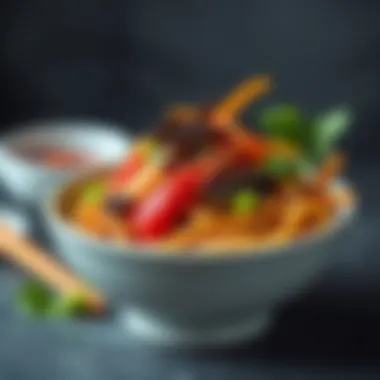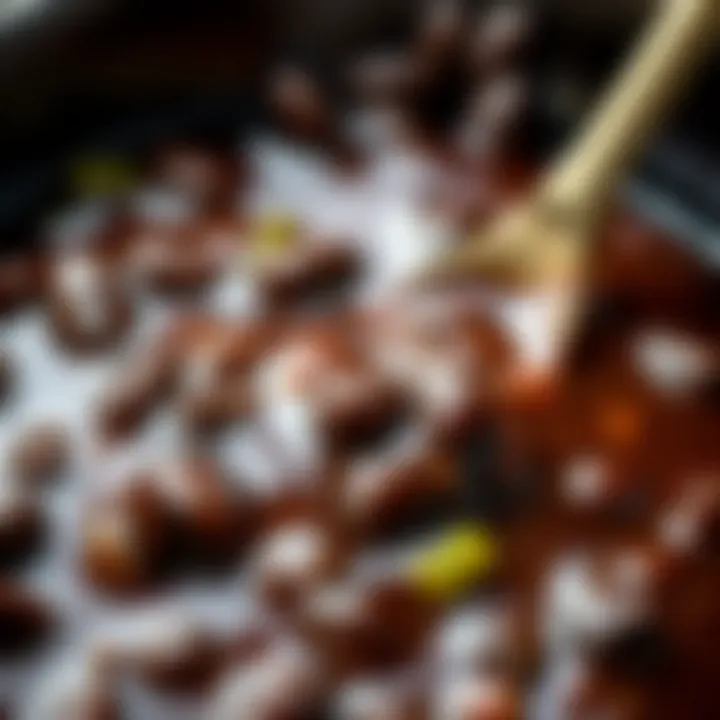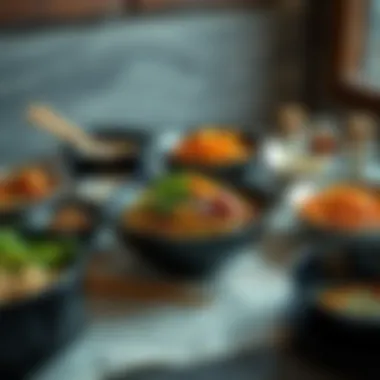Exploring Jajangmyun: A Staple of Korean Cuisine


Intro
Jajangmyun is not merely a dish; it's an experience that encapsulates a slice of Korean culture and gastronomy. This beloved culinary staple features thick wheat noodles slathered in a rich, savory black bean sauce. When you dip into a bowl of this nuanced fare, you're not just tasting flavors but also a long and intricate history that has shaped its presence in the Korean dining landscape.
The dish has roots that trace back to Chinese cuisine, specifically the province of Shandong, but it has evolved dramatically along its journey, reflecting the tastes and preferences of the Korean palate. Many families consider making jajangmyun on special occasions or weekends, marking not just a meal but also a cultural tradition passed down through generations. In this exploration, we will dive deeper into the world of jajangmyun, spotlighting its origins, distinct preparation methods, and variations that showcase its evolution over time.
With each bite, one can appreciate the interplay of flavors—sweet, umami, and a hint of bitterness—all from the stark black bean sauce. There are various twists to the recipe, making it accessible for different dietary preferences, without compromising the essence of what jajangmyun truly embodies.
In the sections that follow, we will dissect the components of jajangmyun, offer a comprehensive list of ingredients, and provide substitution ideas for those with dietary concerns. Whether you're a seasoned foodie or someone who's just beginning their culinary adventure, understanding this dish unlocks a new realm of flavor and tradition, connecting us all through food.
The Origins of Jajangmyun
Understanding the origins of jajangmyun provides a crucial backdrop to fully appreciate this dish's rich flavors and cultural resonance. Known as a staple in Korean culinary tradition, its genesis intersects with sociopolitical history, immigration waves, and the fusion of tastes over time. To appreciate jajangmyun properly, we must explore its historical roots and the significant cultural context surrounding it.
Historical Background
The roots of jajangmyun can be traced back to the late 19th century, particularly during the Qing Dynasty in China. While many are unaware, this dish is heavily influenced by a Chinese noodle dish known as zhajiangmian. It arrived in Korea, particularly in Incheon, through Chinese migrant workers, who adapted the traditional recipe to accommodate local ingredients.
The exact year is hard to pinpoint, but it is believed that the adaptation happened in the early 1900s, after the Sino-Japanese War. It quickly became a comfort food for the local population, weaving itself into the fabric of Korean cuisine. As Korea underwent immense change, especially during the Japanese occupation, jajangmyun transformed from a Chinese dish into a distinctly Korean culinary identity. It became particularly popular among working-class families for its affordability and ease of preparation.
The dish gained a solid foothold in Korean life after the Korean War around the 1950s when urbanization brought about the rise of noodle shops. Places specializing in jajangmyun began popping up in various neighborhoods, making it a popular choice for quick meals.
Cultural Significance
Jajangmyun is more than just a meal; it resonates as a symbol of resilience and adaptation within Korean culture. It encapsulates the spirit of fusion — merging Chinese origins with local ingredients — representing the intermingling of flavors and ethnicity. Over the decades, this dish has evolved, symbolizing comfort and togetherness for many families.
It also plays an essential role in celebratory contexts, such as birthday celebrations and gatherings, reflecting a nostalgic touch, reminiscent of family traditions. Eating jajangmyun is often tied to a sense of community, taking place over shared meals rather than solitary experiences.
Families in South Korea have even initiated a cultural practice of consuming jajangmyun on Black Day, which is celebrated on April 14th, a day dedicated to singles and those who did not receive a gift on Valentine's Day. It’s a humorous acknowledgment of the dish's popularity in a cultural context, linking personal narratives with the communal fabric.
Furthermore, it has garnered attention on the international stage, being featured in Korean dramas and movies, thus accentuating its place within the wider Asian cuisine movement. The enduring love for jajangmyun, both locally and internationally, highlights how food is a melancholy reminder of home and also a gateway to new experiences.
“Food is our common ground, a universal experience.” — James Beard
Ingredients and Preparation
The process of making jajangmyun goes beyond just assembling ingredients; it embodies a culinary craft that brings together diverse elements to create a cohesive dish that resonates with history and culture. Understanding these ingredients and the methods of preparation is crucial for anyone wanting to appreciate or recreate this classic Korean noodle dish. This section delves into essential components, providing a step-by-step guide for aspiring chefs, as well as cautionary advice on common pitfalls.
Essential Components
When preparing jajangmyun, a few core ingredients lay the foundation for this flavor-packed experience. The star of the show is undoubtedly the black bean paste, known as chunjang. This fermented ingredient imparts a rich, umami-laden depth that defines the dish. Other vital players include:
- Wheat noodles: These should be thick and chewy, ideally handmade or from a reputable brand.
- Pork: Generally, diced pork belly is preferred for its succulent texture, though many variations include seafood or chicken.
- Vegetables: Typically, a mix of onions, zucchini, and potatoes offers sweetness and freshness to the sauce.
- Cooking oil: A good quality oil, such as sesame oil, is crucial to enhance the flavors.
A simple yet hearty combination of these components constitutes the heart of jajangmyun, where the flavors mingle in harmony. Each ingredient provides not only flavor, but also texture and nutrition, underscoring why it is cherished among food enthusiasts.
Step-by-Step Preparation
Crafting jajangmyun is a rewarding endeavor, and while it may seem daunting, following these straightforward steps will guide you through the process:
- Begin by cooking the wheat noodles in boiling water until they are al dente. Drain and rinse under cold water to prevent sticking.
- In a separate pan, heat a spoonful of cooking oil. Add your diced pork and cook until browned. This step ensures that the meat develops flavor and a pleasant texture.
- Toss in your chopped onions and sauté them until they become translucent. This moment is key; the onions should sweat just enough to release their sweetness without browning.
- Add your vegetables of choice and continue to stir-fry until they soften. This generally takes about three to five minutes.
- Now, introduce the chunjang to the pan, combining it well with the meat and vegetables. Splash in a bit of water or stock to help the sauce emulsify, creating a glossy coating.
- Allow it to simmer for a few minutes, letting the flavors meld together. A dash of sugar can round out the taste if you prefer a slightly sweeter profile.
- Finally, serve the mixture over a bed of noodles and garnish with cucumber slices or scallions as desired.
This step-by-step journey captures the essence of making jajangmyun. Following these guidelines will help preserve the authentic spirit of the dish while allowing personal touches.
Common Mistakes to Avoid
Even seasoned cooks may run into trouble when making jajangmyun. Here are a few frequent missteps to watch out for:


- Overcooking the noodles: Achieving that perfect chewy texture is crucial. Make sure to follow package instructions precisely and rinse the noodles afterward.
- Using too much or too little chunjang: Finding the right balance of the black bean paste is essential. If you add too much, it can overwhelm the dish with saltiness; too little, and it won’t achieve that characteristic flavor.
- Neglecting the vegetables: Failing to include an adequate amount of vegetables not only impacts flavor but also the health aspect of the dish. Don't skimp on variety or quantity.
- Skipping the simmering step: This short cooking period allows the flavors to develop. Rushing this step might lead to a disjointed taste.
By keeping these common errors in mind, you can further refine your jajangmyun-making skills and ensure a dish that’s both delicious and emblematic of Korean culinary tradition.
In summary, mastering the ingredients and preparation techniques for jajangmyun comes with time and practice. Embracing these details is crucial; they are where the magic happens, transforming simple elements into a celebrated dish that offers both comfort and delight.
Variations of Jajangmyun
When we think about jajangmyun, many may picture the classic dish with its rich black bean sauce and tender pork. However, the beauty of jajangmyun lies in its versatility, transcending regional borders and adapting to different dietary needs. This section explores the diverse variations of this beloved dish, highlighting how they cater to different tastes and preferences while still honoring the original essence of jajangmyun.
Vegetarian Options
For those who prefer to avoid meat, vegetarian jajangmyun has carved its niche within this culinary sphere. It's not merely a replacement but rather an exploration of flavors that can rival its traditional counterpart. Instead of pork, ingredients like tofu or a myriad of vegetables—such as zucchini, mushrooms, and bean sprouts—are introduced.
The key here is the sauce; it can be made with a base of vegetable broth infused with fermented black bean paste, ensuring a rich and savory flavor. One could also experiment with miso or gochujang for a bit of a kick. Many places offer a "veggie jajangmyun" option on their menus, catering specifically to the meatless crowd. This variation allows more people to enjoy jajangmyun while maintaining its unique taste and texture.
Not only does a vegetarian adaptation promote a healthier lifestyle, but it also encourages creativity in the kitchen. Here are a few suggestions for ingredients:
- Tofu: Provides a protein punch and absorbs flavors beautifully.
- Mushrooms: Their umami qualities can mimic the satisfaction of meat.
- Seasonal Vegetables: They contribute freshness and color, appealing to the eyes and palate alike.
"Experimentation in the kitchen can lead to fantastic discoveries, making traditional dishes such as jajangmyun come alive in new ways."
Regional Differences
Jajangmyun's journey across the globe has birthed various regional interpretations worthy of attention. In South Korea, for example, variations can be found depending largely on province. The iconic Jinju-style jajangmyun, typically hailing from the southern part of Korea, often emphasizes seafood over meat, integrating elements like squid or clams. On the other hand, the Incheon-style of jajangmyun may feature a heartier sauce, traditionally paired with fried onions for a delightful crunch.
Beyond the borders of Korea, immigrants have taken this dish and made it their own. In places like China, where similar black bean dishes exist, you might find more complex flavors through the inclusion of region-specific spices. Meanwhile, in Western countries, fusion styles have emerged where jajangmyun sometimes incorporates elements from Italian pasta dishes, such as adopting more creamy sauces. This adaptation serves as a testament to jajangmyun's ability to mesh into various culinary landscapes without losing its identity.
In summary, whether you are enjoying a classic version from a street vendor in Seoul or sampling a gourmet take in a high-end restaurant, the variations of jajangmyun showcase the adaptability of this dish. Each iteration tells a story about its makers and the environment they inhabit, inviting food enthusiasts everywhere to take a taste of these local flavors.
Nutritional Aspects of Jajangmyun
Understanding the nutritional aspects of Jajangmyun is pivotal, especially for those who savor this delicious dish regularly. This dish's composition reflects not just indulgence, but also a certain level of sustenance that value-conscious diners appreciate. With its base of noodles and savory black bean sauce, Jajangmyun packs distinguishable elements that cater to both taste and dietary needs.
Caloric Content and Macronutrients
When digging into the caloric content, one portion of Jajangmyun typically lands around 600 to 800 calories, largely depending on the ingredients used and the portion size. This makes it quite a hearty meal, often serving as a complete dish on its own without the need for additional sides.
Macronutrient Breakdown
A standard serving contains several key macronutrients:
- Carbohydrates: The wheat noodles are the primary source, offering essential energy for daily activities. A single serving can yield around 85 grams of carbohydrates, making it a favorite among those needing quick energy.
- Protein: Typically, the dish may contain about 20 grams of protein, mainly from the pork or vegetables included. This aspect is vital for muscle repair and growth, catering to active individuals.
- Fats: The fat content can vary but often hovers around 10-15 grams, primarily from the black bean sauce and any oils used during preparation.
This balance of macronutrients makes Jajangmyun not only filling but also a fairly complete meal, satisfying the body’s needs without going overboard on calories.
Health Considerations
Incorporating Jajangmyun into one's diet brings with it several health considerations, making it important to know when and how to enjoy it. Here are some points to ponder:
- Sodium Content: Traditional Jajangmyun can be high in sodium, mainly due to the black bean sauce. Those monitoring their sodium intake should be cautious, as excess sodium can lead to health issues over time.
- Fiber Intake: If you opt for whole wheat noodles or add additional vegetables, you can boost the fiber content of the dish, aiding digestion and overall health.
- Customization: One great thing about Jajangmyun is its adaptability. Fat-conscious diners might swap out pork for tofu or simply load up on vegetables, making Jajangmyun experimental and healthier.
Despite its indulgent reputation, Jajangmyun can fit into a well-rounded diet by being mindful of its nutritional content and how it aligns with individual dietary needs. Much like with any food, moderation and awareness are key.
Ultimately, enjoying Jajangmyun does not mean neglecting health; it’s all about balance and smart choices.
Serving Suggestions
When it comes to enjoying Jajangmyun, serving suggestions play a pivotal role in enhancing not just the taste, but also the overall dining experience. Understanding how to serve this dish properly can transform a simple meal into a culinary delight. You’ll find yourself drawn into a web of flavors, textures, and aromas, making each bite unforgettable. In this section, we’ll explore traditional accompaniments that complement this tasty dish, as well as modern adaptations that keep the experience fresh and exciting.


Traditional Accompaniments
The joy of Jajangmyun is amplified by its traditional side dishes, often seen in Korean meals. These not only supply balance but also bring out the depths of flavors in the black bean sauce. Here’s a closer look at what typically accompanies Jajangmyun:
- Kimchi: No serving of Korean food feels complete without kimchi. Its fermented tanginess cuts through the richness of the noodles, enhancing each mouthful.
- Pickled Radishes (Danmuji): This vibrant yellow radish provides a crisp, refreshing contrast. The sweetness and slight crunch are simply a match made in culinary heaven.
- Steamed Egg (Gyeran-jjim): A soft, fluffy steamed egg can add a comforting element to the distinct savory notes of Jajangmyun. It's light and satisfying, a wonderful way to enjoy more protein.
- Green Onions: Finely chopped green onions sprinkled on top bring a fresh touch, adding a burst of color and flavor. They not only add zest but also enhance the presentation.
In Korean cuisine, the idea of balance is paramount. Each bite is a journey, a melody where flavors harmonize beautifully, allowing the richness of Jajangmyun to shine through without overwhelming the palate.
Modern Twists on Serving
As culinary creativity continues to thrive, chefs and home cooks alike have taken the classic Jajangmyun and added their own personal flair. Here are some innovative ways to serve this beloved dish:
- Fusion Bowls: Picture a bowl adorned with crisp vegetables like bell peppers, broccoli, and even avocado. It paints a lovely picture of health and vibrancy, while lightening up the traditional dish.
- Spicy Variants: Adding elements like gochujang (Korean chili paste) can appease those who crave heat. A spicy take on Jajangmyun can tantalize the taste buds, offering a whole new layer of complexity.
- Seafood Jajangmyun: Incorporating seafood such as shrimp or squid can take this dish to coastal heights, melding the black bean sauce with the ocean's bounty. Each bite is a delightful surprise of brininess alongside the savory notes.
- Noodle Variations: While wheat noodles are the norm, trying sweet potato or even zucchini noodles can create gluten-free and lighter alternatives, appealing to health-conscious diners.
The world of Jajangmyun transforms with every modification. It invites not only those who cherish tradition but also adventurous eaters willing to step outside the box. By experimenting with these modern twists, diners can enjoy a dynamic range of flavors and textures that keep Jajangmyun relevant in today’s culinary landscape.
The beauty of Jajangmyun lies in its adaptability—every twist and turn adds layers to an already rich experience!
Cooking Techniques for Jajangmyun
Mastering the cooking techniques for jajangmyun is integral to capturing the essence of this beloved dish. These methods not only impact the flavor but also the texture of the noodles and sauce, ultimately dictating the dining experience. A successful jajangmyun comes down to the proper preparation of both the noodles and the sauce, making it crucial to pay attention to each step in the process.
Proper Noodle Preparation
The foundation of jajangmyun lies in the noodles. Typically made from wheat flour, they require just the right treatment to achieve that chewy, perfect consistency. Here’s how to prepare them properly:
- Select Quality Noodles: When searching for the right noodles, it’s wise to pick fresh ones if available. Dried noodles will also work fine, but always check for a thick texture that can hold the sauce well.
- Boil with Care: Start by bringing a large pot of water to a rolling boil. Add a pinch of salt for flavor. Once the water is boiling, toss in your noodles. Stir gently to keep them from sticking together. Common practice is to cook them for about 5 to 7 minutes, ensuring they're al dente. Remember, they will continue to cook slightly once mixed with the hot sauce.
- Rinse with Cold Water: After draining the noodles, give them a quick rinse under cold water. This halts the cooking process and stops them from becoming gummy. It’s a step many might overlook, but it’s vital for achieving the right texture.
- Toss with Oil: A small amount of sesame oil can be added to the noodles after rinsing. This not only adds flavor but also prevents them from clumping together before serving.
Sauce Preparation Techniques
The black bean sauce is the heart and soul of jajangmyun. Getting the sauce just right can take a dish from average to unforgettable. Here's how to prepare the sauce effectively:
- Begin with Base Ingredients: Start with a good quality black bean paste (chunjang). This fermented paste provides the deep color and umami flavor characteristic of jajangmyun. Along with the black bean paste, you will need diced pork (or a meat substitute), onions, zucchini, and possibly other vegetables like potatoes for added texture and taste.
- Sauté the Ingredients: Heat a nonstick pan over medium heat. Begin by adding a small amount of oil, then sauté diced onions until they turn translucent. Next, toss in the meat and cook until browned. This layering brings depth to the overall flavor.
- Incorporate the Black Bean Paste: Add the black bean paste and stir well, allowing it to caramelize slightly. This step brings out the sweetness in the beans. To prevent burning, keep the heat moderate and stir consistently.
- Balance with Liquid: Gradually add water or broth to create the desired sauce consistency. Allow it to simmer, which melds the flavors beautifully. Throughout the simmering process, taste and adjust with a little sugar or soy sauce, depending on your preference.
- Final Touches: Just before serving, you may wish to thicken the sauce with a cornstarch slurry if you prefer a richer mouthfeel. This technique helps adhere the sauce nicely to the noodles.
"The cooking techniques involved in preparing jajangmyun are an art and science, reflecting the intricacies of Korean culinary heritage."
Through these precise cooking techniques, both the noodles and sauce become better than the sum of their parts, delivering a dish that resonates well with food lovers everywhere. Understanding these elements not only enriches one’s cooking repertoire but also deepens one’s appreciation for Korean cuisine.
The Role of Jajangmyun in Korean Cuisine
Jajangmyun serves as more than just a meal; it’s a symbol of Korean culinary identity and history. Its significance lies not only in the dish itself but also in how it represents the melding of cultures, showcasing both traditional and modern elements. This noodle dish, characterized by its rich black bean sauce, stands prominently within both everyday and celebratory meals, marrying flavors that resonate with many.
Comparison with Other Noodle Dishes
When observing the landscape of noodle dishes across the globe, Jajangmyun can fiercely stand its ground. In Korean cuisine, other popular noodles like Jjampong and Kuy Teav from Cambodia exist within the same family, yet they boast distinct flavors and profiles.
- Jjampong is known for its spicy, seafood-based broth and typically larger noodles. It’s a far cry from the savory sweetness of Jajangmyun.
- On the other end, dishes like Ramen from Japan and Pho from Vietnam offer their own unique spin with spicy and aromatic profiles that engage different taste senses.
While Jajangmyun shares its familiarity of wheat noodles with these dishes, it carves out a niche with its robust black bean flavor, often dolloped with diced vegetables and meat.
Here are some key points of comparison:
- Flavor Profile: Jajangmyun's sweet and salty taste contrasts sharply with the spiciness of Jjampong or the herbal notes of Pho.
- Preparation Techniques: The techniques involved in crafting the black bean sauce are a dance of tradition, differing greatly from the broth-based approaches of other noodle styles.
- Cultural Role: Each dish holds a special place in its respective culture, but Jajangmyun has a particular nostalgic resonance, often associated with comfort and home cooking in Korea.
The comparison highlights that while Asian noodle dishes have parallels, Jajangmyun brings a unique aspect to the table, enriching the overall tapestry of the cuisine.
Jajangmyun in Contemporary Dining


In modern Korean society, Jajangmyun has gracefully transitioned from street food to a beloved staple in both homes and restaurants. Its presence has expanded beyond traditional boundaries, reflecting the evolving tastes of younger generations.
Today, you’ll encounter Jajangmyun not just in the traditional black or white bowl, but in a multitude of innovated forms:
- Gourmet Versions: Some restaurants have begun experimenting with upscale ingredients, like truffles or handcrafted noodles, taking this classic dish to new heights.
- Fusion Cuisine: There are even instances where chefs blend Jajangmyun with elements from other culinary traditions. Think Jajangmyun tacos or Jajangmyun and cheese baked dishes.
Furthermore, this dish is not merely confined to Korean restaurants. As Korean pop culture gains global recognition, eateries around the world are crafting their own interpretations. Jajangmyun, once reserved for special occasions or lazy Sundays, now dazzles in various culinary landscapes, drawing in food enthusiasts eager to experience a taste of Korea.
Jajangmyun, with its unique flavor and versatility, is a reflection of the dynamic nature of Korean cuisine, continually evolving while staying deeply rooted in tradition.
For more insights into the influence of Korean cuisine in the world today, you might find this resource enlightening: Britannica on Korean Cuisine and to explore traditional names and dishes, visit Wikipedia on Jajangmyun.
Engaging with this dish opens up a conversation about identity, history, and the future of culinary endeavors that continues to resonate with food lovers everywhere.
Global Influence of Jajangmyun
Jajangmyun has carved out quite the niche in the tapestry of global cuisine. This culinary icon, with its rich and savory black bean sauce, extends well beyond the borders of Korea and into the hearts and bellies of many across the globe. As we explore the wider impact of Jajangmyun, it’s essential to consider how this dish resonates within the Korean diaspora and how it adapts to the international palate, alongside its role in popular culture.
Korean Diaspora and International Adaptations
Korean immigrants have taken their culinary traditions with them, sharing dishes like Jajangmyun in countries they’ve settled in. One of the significant impacts of this diaspora is how the original recipe morphs to align with local tastes and ingredients.
In places like the United States and Canada, Jajangmyun becomes a canvas for fusion cooking. You might find it prepared with ingredients typical to the region or perhaps paired with local favorites. For instance, in some corners of Los Angeles, it’s not uncommon to see Jajangmyun served with a sprinkle of cheddar cheese, a nod to Western tastes.
On the other hand, cities like Seoul feature various adaptations that incorporate diverse regional ingredients, resulting in unique flavor profiles that enhance the dish’s versatility. This adaptability speaks volumes about the dish’s ability to resonate with different cultures, making it more than a traditional meal, but a bridge connecting diverse culinary worlds.
Here are a few notable adaptations to consider:
- Cheese Jajangmyun: A trend in many Asian countries where cheese is melted on top, creating a wonderfully creamy texture.
- Seafood Jajangmyun: Incorporating local seafood like shrimp or squid adds a fresh dimension.
- Healthier Versions: Some adaptations are lighter, using zucchini noodles as a base or implementing more vegetable-heavy sauces to appeal to health-conscious consumers.
These adaptations not only broaden the appeal of Jajangmyun but also foster cultural exchanges in the kitchen, creating exciting discussions and trials among food lovers.
Jajangmyun in Popular Culture
The influence of Jajangmyun isn't just confined to the kitchen; it also permeates popular culture. Films, television shows, and online media all highlight this beloved dish, often showcasing it as a staple of comfort food.
In South Korean dramas, Jajangmyun frequently appears as a symbolic meal, representing love, familial bonding, or even the simpler pleasures of everyday life. For example, many dramas feature characters sharing a bowl of Jajangmyun during heartwarming scenes, further embedding the dish into the cultural fabric.
Outside of Korea, Jajangmyun has become a topic of interest among food vloggers and influencers, who present their interpretations and experiences with the dish. Platforms like YouTube and TikTok have seen a rise in cooking demonstrations and taste tests, making Jajangmyun accessible to a younger, global audience. These reviews and showcases not only bring attention to the dish but also stir curiosity about its origins and variations.
Despite its humble roots, Jajangmyun is a testament to how food can transcend borders and cultures, forging connections through shared experiences.
As its popularity continues to grow, Jajangmyun stands as more than just a meal; it's a cultural narrative, a flavor experience, and a unifying symbol of Korean culinary heritage.
Closure
The conclusion serves as the heartbeat of this article, weaving together all the threads of knowledge about Jajangmyun. It underlines the dish’s significance not only in the realm of culinary arts but also within the cultural tapestry of Korea and beyond. The enduring nature of Jajangmyun reflects how food acts as a bridge connecting generations, families, and even different cultures. Its rise from humble beginnings to being recognized on international plates highlights its unique ability to adapt while retaining core flavors.
The Enduring Appeal of Jajangmyun
Jajangmyun’s charm lies in its simplicity and the robust layering of flavors. The rich black bean sauce, usually coupled with hearty pork and an assortment of vegetables, delivers a satisfying umami experience. This dish is beloved across generations, often evoking warm memories of family gatherings or late-night takeout. Its adaptability to suit various dietary preferences, including vegetarian options, makes it a versatile choice for many.
The dish resonates well with younger audiences too due to its prominent presence in pop culture—think of the many references in Korean dramas or the endless social media posts highlighting the dish. The joy of slurping up those chewy noodles, paired with a flavorful sauce, creates a sensory experience that goes beyond just taste. It’s a comfort food for many, making it a staple not just at home but also in restaurants where it proudly holds its own.
"Food is a universal language, and Jajangmyun is its delicious dialect."
Encouragement to Explore
For anyone curious about diving deeper into the world of Jajangmyun, the journey does not end with merely understanding its ingredients or preparation methods. It's about experiencing the dish in various settings, from street food stalls to upscale dining establishments. Each interpretation offers a unique flavor profile and cooking technique, enriching one’s appreciation for this beloved dish.
Consider trying your hand at making Jajangmyun at home, leveraging local ingredients and tailoring the flavors to your preference. Join cooking classes or even engage with online communities dedicated to Korean cuisine. Forums like reddit.com/r/KoreanFood can provide invaluable insights and tips on perfecting your dish.
Each bowl of Jajangmyun comes with a story, a cultural connection, and an invitation to share in the communal aspect of food. So, whether you are dishing it out among friends, savoring in solitude, or experimenting in your kitchen, let each experience remind you of the beauty of culinary discovery.
Explore more about Jajangmyun on platforms like Wikipedia and Britannica. With every bite, you are tasting a piece of history that has evolved while keeping its heart intact.















